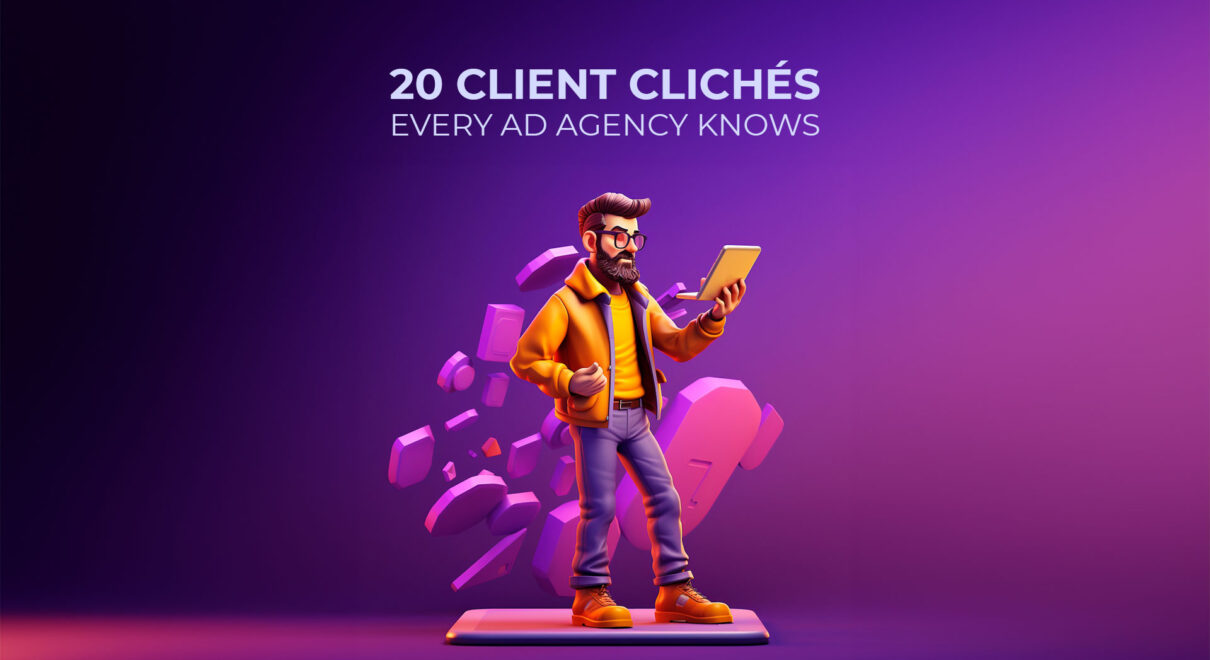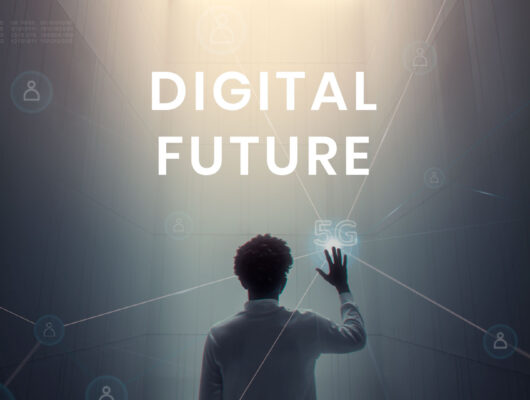Working in an advertising agency is an exciting journey filled with creativity and innovation. However, it often comes with its share of client clichés – those requests and comments that seem to pop up time and time again, regardless of the project or client. Here’s a lighthearted look at 20 common client clichés that ad agencies encounter, and how they navigate these familiar waters with a blend of professionalism and creativity.
1. The Big Logo Debate
“Can you make the logo bigger?” It’s a classic request that often leads to a delicate dance between maintaining design integrity and meeting client desires.
Making the logo bigger often disrupts the visual harmony and balance of a design. A larger logo can overpower other important elements, detracting from the overall message and aesthetic appeal. Effective branding is about more than size; it’s about the logo’s integration and interaction with the entire design.
2. The Quest for Perfection
“I’ll know what I want when I see it.” This phrase challenges agencies to become mind-readers, often resulting in multiple revisions until the ‘Eureka’ moment is reached.
This open-ended approach can lead to an endless cycle of revisions, consuming significant time and resources. Effective marketing often requires decisiveness and clarity of vision, and this type of indecision can hinder the creative process and delay project completion.
3. The ‘Pop’ Factor
“Can we make it pop more?” This usually translates to adding more color, contrast, or dynamic elements – but it’s always a balancing act.
The vague desire to “make it pop” lacks specific direction and can lead to overdone designs. Clarity in design objectives is crucial for creating visuals that are both appealing and aligned with the brand’s message, rather than just being loud or eye-catching.
4. Viral Dreams
“Let’s try to make it go viral.” While going viral is the dream, agencies know it requires the perfect mix of content, timing, and a bit of luck.
Aiming solely for virality can overshadow the importance of meaningful content. Viral content is unpredictable and often a byproduct of quality and relevance rather than a viable standalone goal. Focusing on genuine engagement and value often yields better long-term results.
5. Brand Dilemma
“I want it to look exactly like Amazon, but different.” Agencies walk the tightrope of drawing inspiration without losing originality.
Imitating another brand, even slightly, risks losing originality and authenticity. While taking inspiration is normal, distinct branding is essential in establishing a unique identity in the market. Originality, not imitation, is what sets a brand apart.
6. The Race Against Time
“Can we have this by tomorrow?” Agencies are no strangers to tight deadlines, and often it’s their agility that saves the day.
Excessively tight deadlines can compromise the quality of the output. Creative excellence often requires time for ideation, development, and refinement. Rushed projects may not deliver the best results, reflecting poorly on both the agency and the client.
7. The Illusion of Choice
“It looks great, but can we see more options?” This is where agencies’ patience and versatility shine, providing alternatives while guiding clients towards effective choices.
Requesting multiple options can lead to decision fatigue and dilute the focus. A more targeted approach, rooted in strategy and research, often leads to stronger, more effective outcomes than scattering efforts across too many alternatives.
8. The Paradoxical Request
“Make it look the same, but totally unique.” This oxymoronic request sparks agencies’ creative engines to find that sweet spot between familiar and innovative.
Asking for something to be both the same and yet unique is inherently contradictory. This confusion can lead to unclear goals and an inefficient creative process. Clear, distinct objectives are essential for effective and coherent design.
9. Decision Ambiguity
“I’m not really sure what I want, but I’ll know it when I see it.” Agencies often interpret this as an opportunity for creative freedom – with a safety net.
This approach often results in a prolonged and directionless project. Without a clear vision, it’s challenging to create designs that meet expectations. Effective collaboration requires a degree of decisiveness and direction from the client.
10. SEO Overdrive
“Can we add more keywords for SEO?” Here, agencies balance SEO needs without compromising content quality.
Overemphasis on SEO can degrade the quality of content, making it less engaging for the actual audience. While SEO is important, striking a balance between optimization and readability ensures content remains compelling and user-friendly.
11. The Outsider’s Opinion
“I showed it to my friend/relative, and they think…” Navigating feedback from outside the project scope requires tact and expertise.
Feedback from non-professionals can lead to misguided changes that detract from the project’s goals. Professional marketing decisions should be based on market research and expert knowledge, rather than the subjective opinions of those outside the field.
12. Photoshop Miracles
“Can’t you just Photoshop it?” This often underestimates the skill and time involved in ‘just Photoshopping’ something.
Feedback from non-professionals can lead to misguided changes that detract from the project’s goals. Professional marketing decisions should be based on market research and expert knowledge, rather than the subjective opinions of those outside the field.
13. The Budget Dilemma
“We don’t have a big budget, but it will be great exposure for you.” Agencies must weigh the value of exposure against their need for fair compensation.
Feedback from non-professionals can lead to misguided changes that detract from the project’s goals. Professional marketing decisions should be based on market research and expert knowledge, rather than the subjective opinions of those outside the field.
14. The Apple Envy
“Can we make the design like Apple’s?” Mimicking a tech giant is no small feat, but agencies often use this as a benchmark for clean, user-friendly design.
Feedback from non-professionals can lead to misguided changes that detract from the project’s goals. Professional marketing decisions should be based on market research and expert knowledge, rather than the subjective opinions of those outside the field.
15. YouTube Inspiration
“Let’s make the video just like this one on YouTube.” While inspiration is great, agencies strive to infuse originality and tailor it to the client’s unique brand.
Feedback from non-professionals can lead to misguided changes that detract from the project’s goals. Professional marketing decisions should be based on market research and expert knowledge, rather than the subjective opinions of those outside the field.
16. Thinking Out of the Box
“I want something completely out of the box.” Agencies love this challenge – it’s an invitation to unleash their most creative ideas.
Feedback from non-professionals can lead to misguided changes that detract from the project’s goals. Professional marketing decisions should be based on market research and expert knowledge, rather than the subjective opinions of those outside the field.
17. The Discount Request
“Can you give us a discount this time?” Agencies must balance client relationships with business viability when handling such requests.
Feedback from non-professionals can lead to misguided changes that detract from the project’s goals. Professional marketing decisions should be based on market research and expert knowledge, rather than the subjective opinions of those outside the field.
18. Universal Appeal
“We want to appeal to everyone.” Agencies know that targeting everyone often means connecting with no one and guide clients towards more specific targeting.
Feedback from non-professionals can lead to misguided changes that detract from the project’s goals. Professional marketing decisions should be based on market research and expert knowledge, rather than the subjective opinions of those outside the field.
19. Fear of White Space
“Let’s add more to the page, it looks too empty.” Educating clients on the power of minimalism and focused messaging is key here.
Feedback from non-professionals can lead to misguided changes that detract from the project’s goals. Professional marketing decisions should be based on market research and expert knowledge, rather than the subjective opinions of those outside the field.
20. Last-Minute Changes
“Can we change the color scheme at the last minute?” Flexibility and quick thinking are agencies’ best friends in these scenarios.
Feedback from non-professionals can lead to misguided changes that detract from the project’s goals. Professional marketing decisions should be based on market research and expert knowledge, rather than the subjective opinions of those outside the field.
20 Client Clichés Every Ad Agency Knows Too Well
These clichés, while often amusing, underscore the dynamic and sometimes challenging relationship between clients and advertising agencies. It’s through these interactions that agencies refine their skills in diplomacy, flexibility, and innovation. At the end of the day, navigating these clichés is part of the journey in creating compelling, successful campaigns that resonate with audiences and fulfill client visions.






